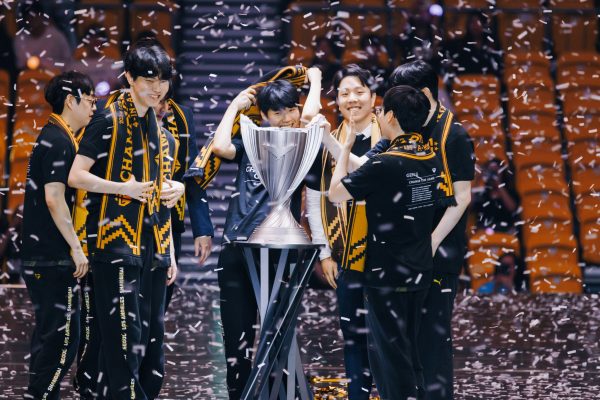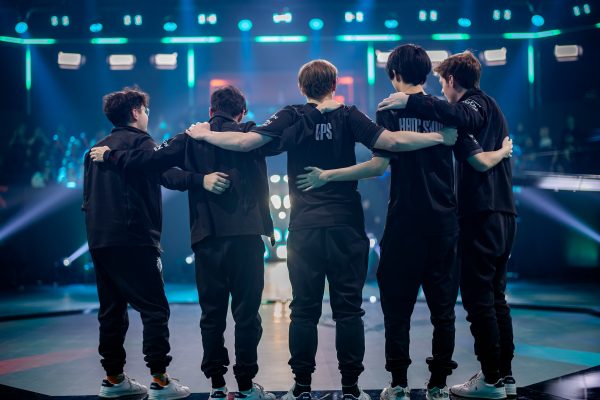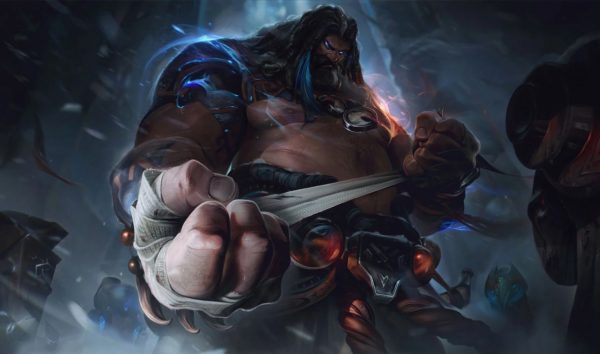In modern day esports, any team fighting for international fame consists of far more than just the players and a coach. Top performances hinge on managers, assistants, cooks, psychologists, physicians… the list of supporting staff is long. Rarely do we get the chance to peek behind the curtains of top teams, though. Esports fans tend to care solely about their heroes’ performances on stage and on top of that, teams are protective of their customs, their secret sauces making their team reach the stars.
Duffman and AngelArcher are key figures in G2 Esports’ success in the LEC. Photo by Michal Konkol for Riot Games / Photo via Luciana Nadrag
G2 Esports is a legendary brand in competitive League of Legends. The team has gone head to head with rival Fnatic for the title of Europe’s best, coming out on top more often than not in recent years. While it is the players who shine bright on-stage, they don’t carry all the weight. When preparing for opponents and polishing their gameplay they heavily rely on the information gathered by their scouts and number-crushers: G2’s analyst team.
What a regular week looks like
The opening match-day of a given LEC week is, interestingly enough, among the quieter days for Christopher “Duffman” Duff and Luciana “AngelArcher” Nadrag. Duffman, Head Analyst of the G2 League of Legends squad, uses the day to briefly chat with is players one more time. “I’ll go through AngelArcher’s scout report from the week before, and go through our scrims in general,” he explains. “I’ll try to find something that I haven’t been able to talk about with the team during the week, or I’ll highlight things that are going to be really important in the game.” Other than that, though, his day is mostly about making sure the G2 players are comfortable and focused on their match.
The same rings true, at least partially, for AngelArcher, G2’s Scout Analyst. Based in the United Kingdom, she can’t do much but support her team from across the North Sea on match days. “My work is already done before the game day starts,” she explains. Live-viewing the matches is a pretty relaxed affair for her: “I could never look at a game live and analyze it there and then. I would always need to watch the VOD back. So, I just watch the LEC matches for fun and to get some idea of what has happened and which games I’m looking forward to to analyze.”
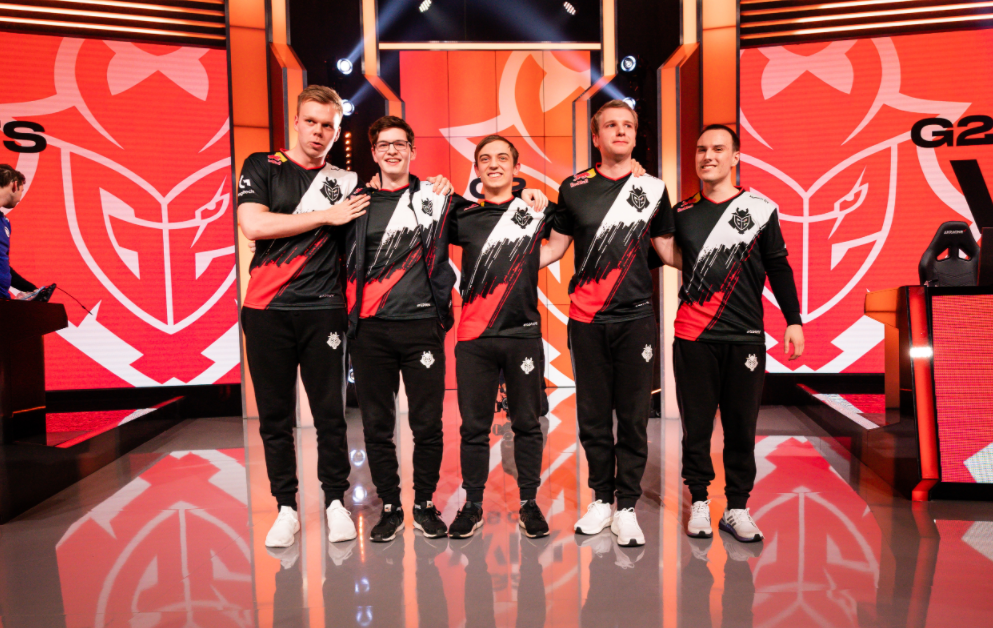
The legendary lineup of G2 has to fight hard this Split. Photo by Michal Konkol for Riot Games.
However, as soon as the first game day is over, her work for G2 begins. The weekends are her territory. Before Sunday, noon, she has to deliver a report to Duffman about the next opponents G2 will face in the LEC. “For me, it’s about in-game stuff. The decision-making of a team, how they move across the map. Objectives are very important in the game right now, so I analyze how teams approach Rift Heralds, dragons, Baron Nashor et cetera.” And that is just the basics of what her analysis entails. Whereas to the viewer only a few teams in the LEC might have a distinct playing style, AngelArcher is tasked with finding the tiniest nuances that makes them unique: “Do they play mid/jungle really well? When the support roams, do they get vision alone or do they play with their jungler? Any sort of difference, I highlight for G2 and say ‘this is what makes them different.’”
With a deadline so soon after the matches end, the weekend’s are a grind for AngelArcher. She reports on four matches for both upcoming opponents. She can analyze matches played in the former weekend during her week days before her deadline, but it’s still a task that consumes more time than most would think. “Luckily, I can manage to watch games on YouTube on a higher speed. I normally watch them on 1.5, or even two times the speed,” she says. After two-and-a-half to three hours of VOD-reviewing, the real challenge starts. “The actual compiling of the report is where it gets to the time-consuming part. That would take me up to three or four hours. For a total, I would say that it’s about seven hours for a report on a team.” Once the report has been submitted, Duffman and AngelArcher both discuss the contents of it. “We tend to pretty much agree on how we approach things. We’ve both seen the same games, we’ve both seen the same footage.”
Before Duffman can share his analyst team’s findings with the players, he turns to Dimitri “Noodlez” Zografos, the Data Analyst on G2’s roster. “Noodlez is there to gather manual data from scrims that we don’t have time to do ourselves. Data we think are really important to the game, such as tracking when our players recall to their base, if players bought a pink ward, or if they have items they could sell for it. That way we see how often our players are actually remembering these things,” Duffman explains. He chuckles: “For some reason it’s very difficult for our players to let go of items and buy pink wards.” Noodlez’s analysis extends all the way to listening to G2’s communications during scrims and dissecting the players’ conversations. Duffman: “This way we can show players that, for example, if they start talking about drakes three minutes before they spawn, then we’re getting them. If they’re not talking about them, then we’re not even close.” About the voice communications, AngelArcher adds: “There is a lot of memeing.”
With all the data ready, Duffman sits down with the Head Coach of the team, Fabian “GrabbZ” Lohmann to talk about the drafts. When that’s done, the players are informed about what has to be focused on during practice. Duffman gives an example: “If our next opponent approaches Rift Heralds in a specific way, we’ll make sure that our players are communicating correctly so that the opponent’s strategy won’t be an issue.” Other times, when the opponent targets a specific lane more, players are reminded to give continuous updates about their lane state so they can pivot accordingly.
During the week, as the scrims play out, Duffman keeps track of the team and if they’re implementing the pointers they’ve been given. If the team is displaying a trend in their gameplay that goes against what they plan to do during their official LEC matches, he reminds them of the strategies they’re aiming for: “It’s a constant reminder that, whatever it is they’re forgetting to do, will be important. Just so it won’t be a surprise during game day.”
G2’s lineup consists of industry veterans. Micromanaging is limited, if present at all. “Our players tend to have the small details covered themselves. They’ve played the game for so long, they’ve played for so long together, they’ll figure the small things out themselves,” Duffman explains. “It’s not about teaching them. It’s about reminding them about things that we can do to make the game easier. Sometimes when you’re so good, you forget that you can take the easy way out and you’ll try to go for the flashy play.”
Making data exciting
Providing analysis is not a job for everyone. It’s tied in with a lot of dry content. “Nine times out of ten, my job is very, very boring so far,” AngelArcher says. However, it’s not because of her job itself. The current meta in League of Legends just makes for uninspiring games to analyze. “It’s just literally the map state right now. All teams play pretty much the same way. They play very boringly, very slow,” she says, continuing: “It’s all very stale and they all look kind of the same. If you take off the name tags, I could not tell you what team is playing right now.” Duffman adds: “Games tend to look the same right now. In the Spring Split, it was a little bit different. Teams weren’t going all-in on drakes and Rift Heralds as much. But this Split, that seems to be all that matters.”
We look at the LPL and LCK specifically, not the LCS.
G2, somewhat ironically, used to be one of the most innovative teams wandering around Summoner’s Rift, picking unique champions and styling on their opponents. This Summer Split, however, even their own team has been relatively quiet. “It partially comes down to the meta. There is not much room to experiment with champion picks. Before, you had a lot more freedom,” Duffman explains. He adds that the team’s readjustment to the role swap plays a factor: “We’ve only got one Split to make it to Worlds. So it’s not about experimenting yet. It’s about getting back to what we were good at, essentially.”
So in a boring meta, where do you find games to enjoy as an analyst? For AngelArcher, it’s in one of G2’s main rivals this year: “The excitement is all MAD Lions for me. They’re a rookie team, they’re explosive, and they seem to have some wacky picks. During the game, they have different shifts in what they’re focussing on.” With the LEC Summer Split Playoff stage approaching, the hope is that more teams will allow themselves to experiment more and stretch the boundaries of the meta.
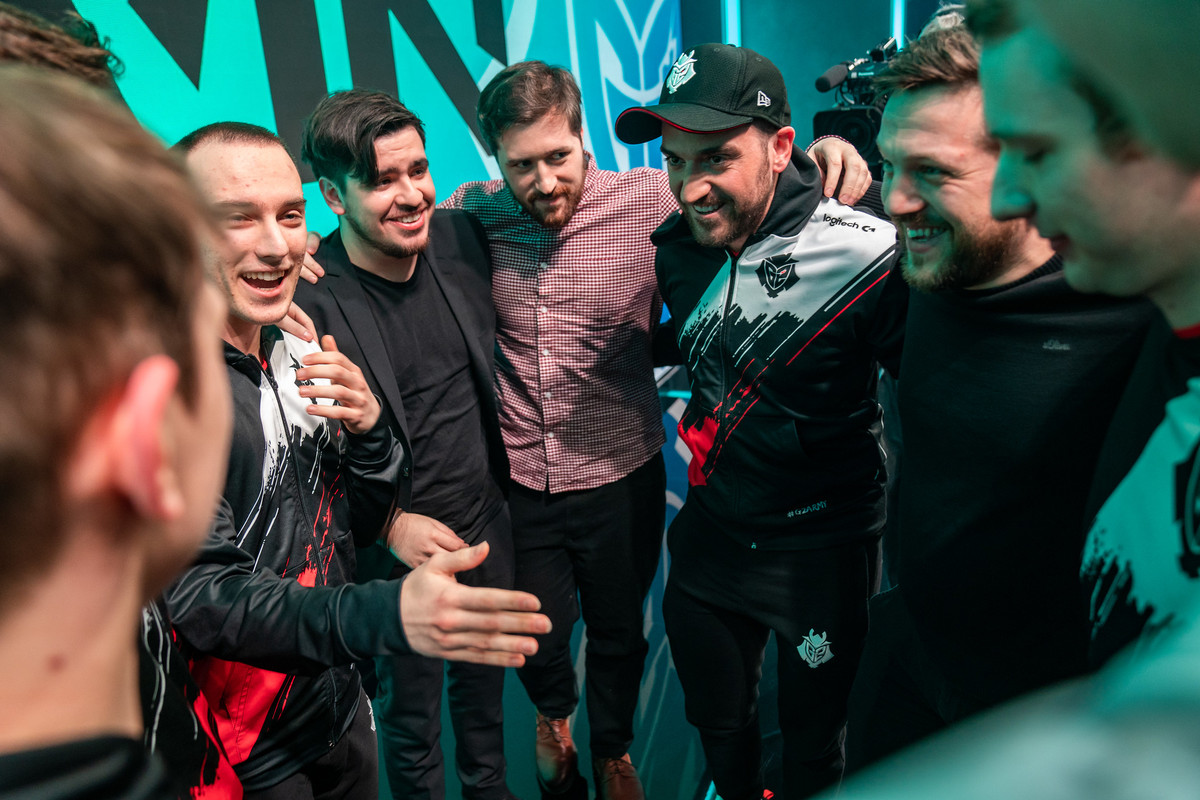
G2 celebrates a victory at the start of this year. Photo by Michal Konkol for Riot Games
But when Europe is boring, thankfully other regions provide plenty of excitement. While preparing for the World Championship, and the teams G2 might face there, is not on the analysts’ mindset yet, other regions do offer learning points. “We look at the LPL and LCK specifically, not the LCS. When I first looked at the LCK, it was very boring to start off with. It has no become a bit more of a fiesta now though, which I like. In the LPL, I think all the teams are kind of interesting, but Top Esports is a team I really like in general” AngelArcher says. For Duffman, another LPL team stands out: “Team WE has some really cool combinations with Galio and Sett. They’re just all over the map. It’s really fun to watch League of Legends like that.”
G2’s analyst team tried to fully analyze the VODs of the other regions, but that proved to be inefficient due to the sheer size of the content. Duffman: “We started looking at international teams to scout how they approach the objectives that are so important in this meta. Whether it’s how they approach the Rift Herald, how they approach drakes, how they use the Baron Nashor buff… anything like that, we present to the team. Just to give them ideas.” Of course, Duffman admits, when watching these teams, he can’t resist to fantasize about playing them at Worlds. “International events, that’s what we’re here for. It’s the goal to play against these big players from around the world. Players who have a completely different life than we do, a different way of approaching everything.”
It’s all a team game
In League of Legends esports, team synergy is of the utmost importance if you want to consistently win. And this transcends the virtual map on which the game is played. The realization that even being an analyst is a team game has made the job not just easier, but far more enjoyable for both Duffman and AngelArcher. “Duffman and I communicate a lot more than the people who I have worked with before. Being remote, you are very isolated and you rely on a lot of communication,” AngelArcher says, drawing from her experience as a remote analyst at other teams. “In the past I would literally just be left on an island, doing my work with minimal communication with anyone. I would just throw my report into the abyss, hoping that they’d received it. I got no real feedback, no nothing.”
Duffman relates: “On teams like Copenhagen Wolves, I would just throw the report to the Head Coach and hope that he’d look at it.” Back in the day, when teams were smaller and each staff member on the team had to take on more responsibilities, there simply wasn’t enough time for everyone to communicate constantly. “When I was working with YoungBuck, for example, I knew he would look at it. But it wasn’t easy for him to communicate about everything that happened. He also had to take care of cooking, preparing stuff for the players… there just wasn’t enough time.”
Knowing how tough it is to feel connected to a team when working as a remote analyst, Duffman knew how he wanted to set up his team of analysts. “At the start of this year, when we brought AngelArcher and Noodlez on, communicating was an important part for me that I wanted to get better at. I wanted to make sure that they felt part of the team.”
So far, Duffman has succeeded. AngelArcher: “Now, I can watch scrims and know what’s going on in the gaming house. But during the Spring Split, I had university exams. I couldn’t watch the team on a day-to-day basis. It was really important to me that Duffman was able to talk to me about how the scrims went, what did work and what didn’t. And he did update me. That level of communication was a new thing for me, here at G2. It has definitely made it a lot easier for me to do my job. And in general, that makes it a lot more fun too.”
